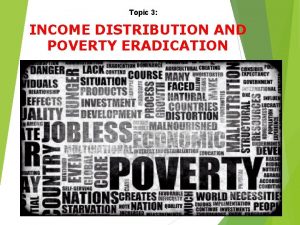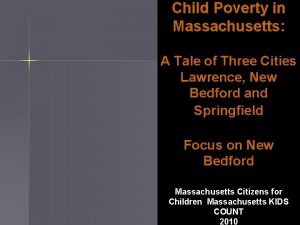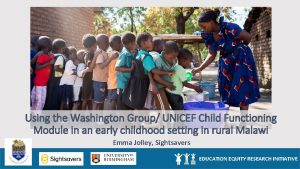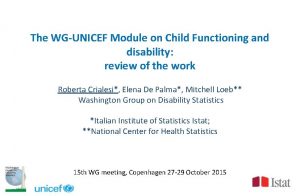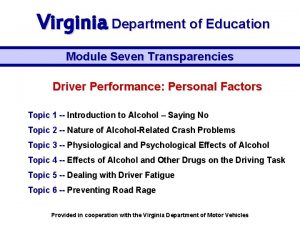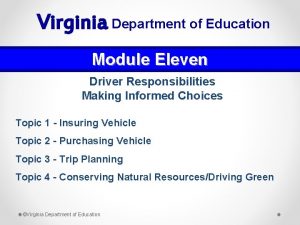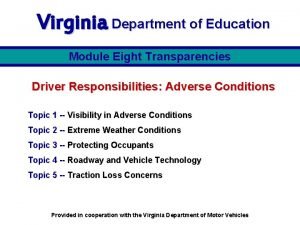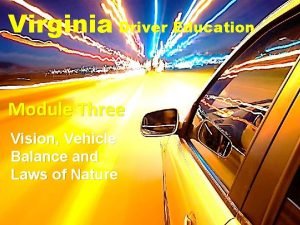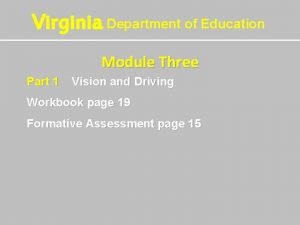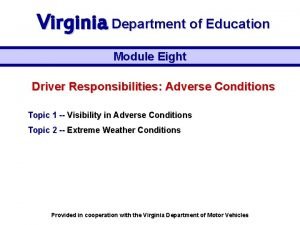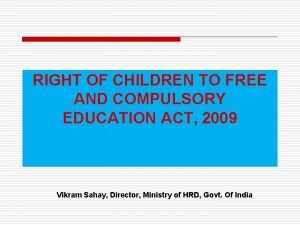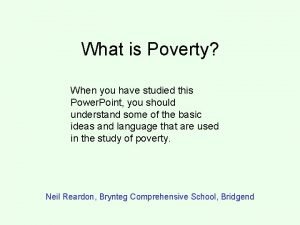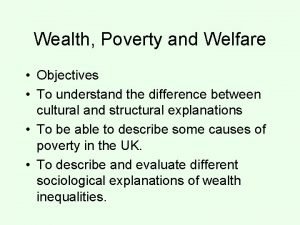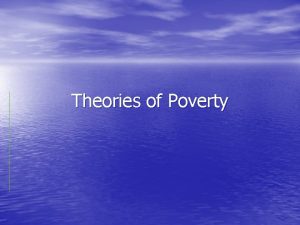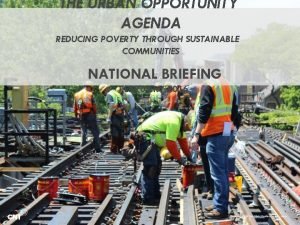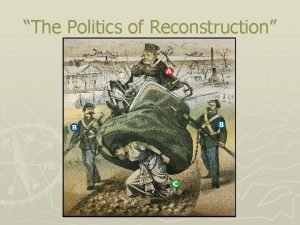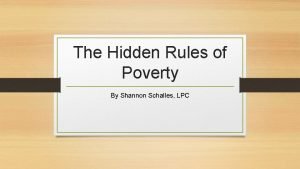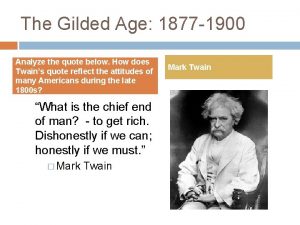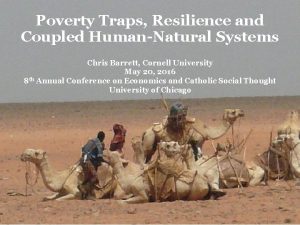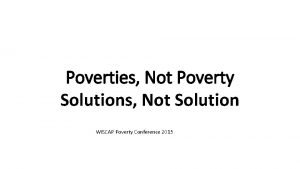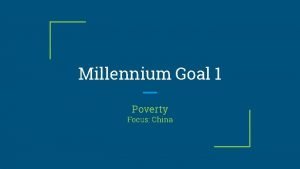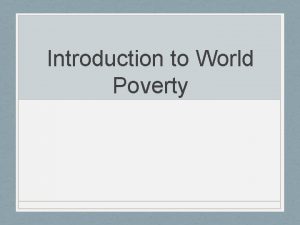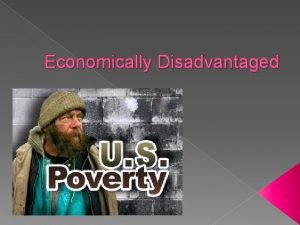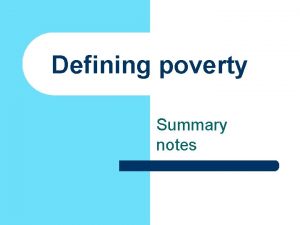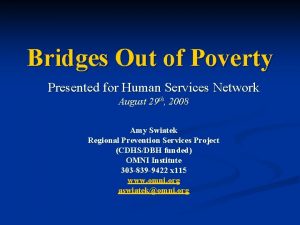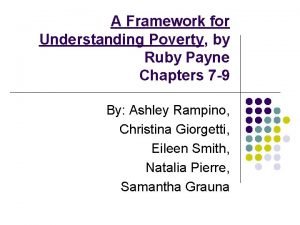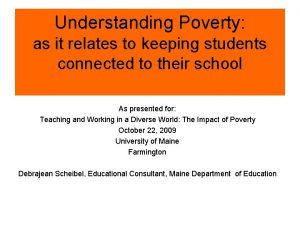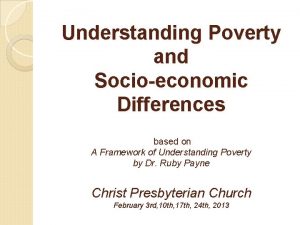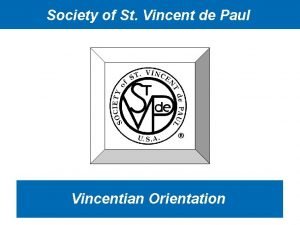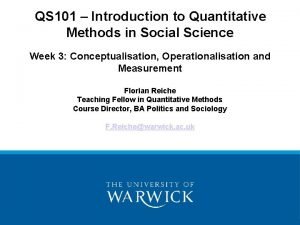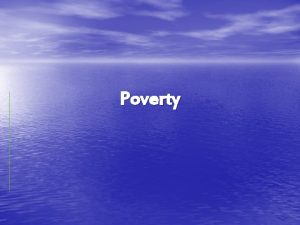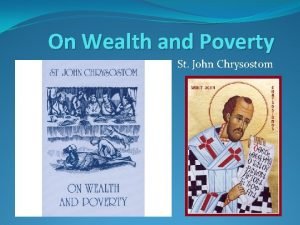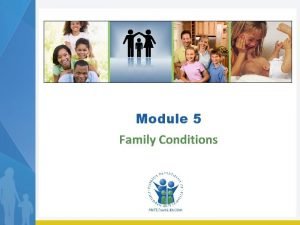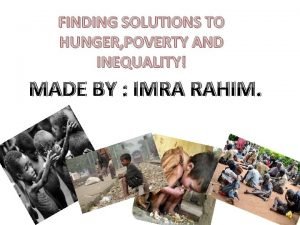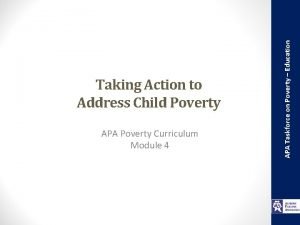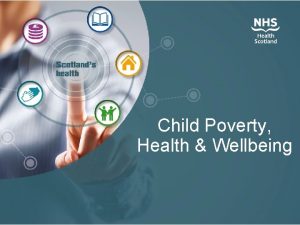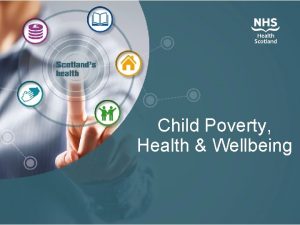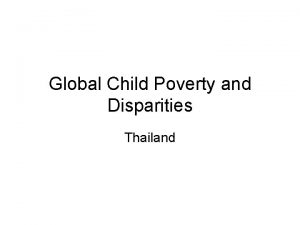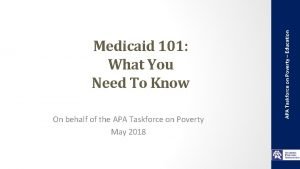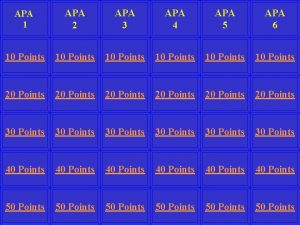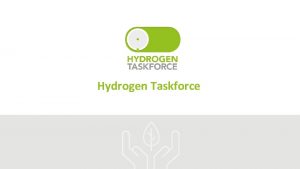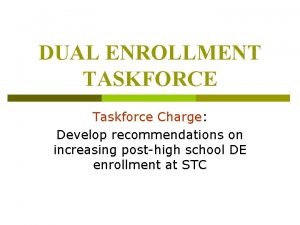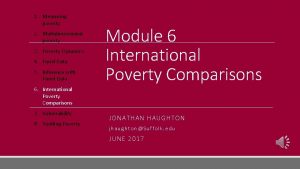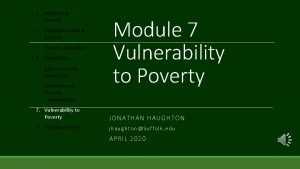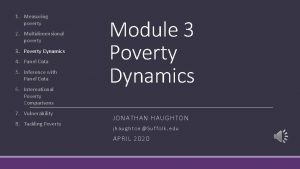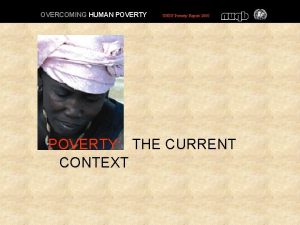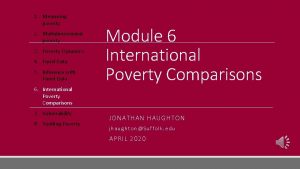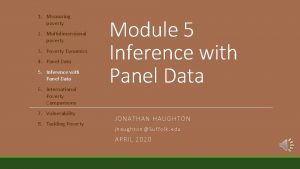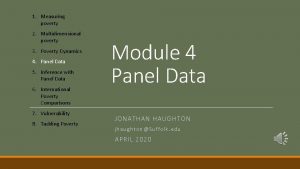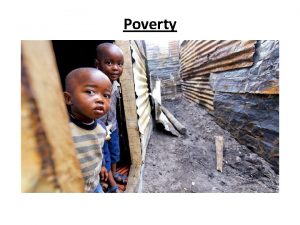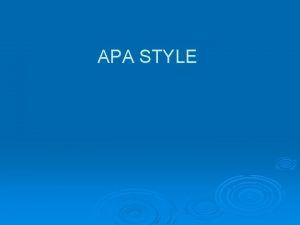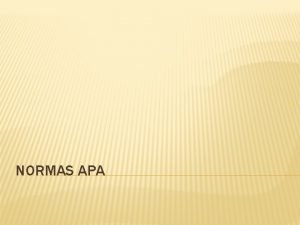APA Child Poverty Curriculum Module 1 APA Taskforce



















































- Slides: 51

APA Child Poverty Curriculum Module 1 APA Taskforce on Poverty – Education Epidemiology of Childhood Poverty

By the end of this module participants will: • Describe the current levels of child and family poverty in the US • Work effectively across the sociodemographic gap between the physician and the child and family living in poverty face APA Taskforce on Poverty – Education Goals

• Define the federal poverty limit and its relationship to public benefits • Contrast the US child poverty rate over time to rates in other developed nations over the past 25 years • Distinguish poverty rates among US subpopulations; consider geography (rural/urban/suburban), race/ethnicity, age, immigrant status, family composition and level of education • Describe poverty rates in your own local practice APA Taskforce on Poverty – Education Specific Objectives – Goal 1

• Contrast the demographics of the physician and child health care provider workforce with the demographics of the US population • Reflect on one’s personal assumptions, biases and stereotypes about impoverished populations and its potential effect on patient care • Conduct culturally sensitive screening for indicators of poverty in one’s own patient population APA Taskforce on Poverty – Education Specific Objectives – Goal 2

• Discuss impact of pre-work • Define Federal Poverty Level • Life at the Poverty Line video • Minimum wage exercise and budget calculator • Consider US vs. Global poverty • Map poverty in your own community • Contrast physician workforce vs. US population • Recognize our unconscious bias APA Taskforce on Poverty – Education Module Roadmap

Reflections? APA Taskforce on Poverty – Education Pre-Work

Define the federal poverty limit and its relationship to public benefits APA Taskforce on Poverty – Education CURRENT LEVELS OF US CHILD AND FAMILY POVERTY

• Poverty Threshold: o Updated annually by the US Census Bureau o Used for statistical purposes • Poverty Guidelines (Federal Poverty Level, FPL): o Issued annually by Dept of Health and Human Services (HHS) o Used to determine eligibility for programs Office of the Assistant Secretary for Planning and Education http: //aspe. hhs. gov/poverty/ APA Taskforce on Poverty – Education How do we define poverty?

Office of the Federal Register, January 22, 2015 https: //www. federalregister. gov APA Taskforce on Poverty – Education A family of 4 is considered to be below the poverty line (FPL) if their annual pre-tax income is less than $24, 250

Has NOT been adjusted for: • Proportionally lower cost of food in 2015 • Cost of living based on geographic location • Higher non-food costs: transportation, child care, medical expenses, housing • Benefits a family receives (ie. , SNAP, WIC) www. nccp. org APA Taskforce on Poverty – Education Official Poverty Measure

Watch this 5 -minute video to get an idea… _ https: //www. youtube. com/watch? v=g 3 i. RRsoqo. MI Catholic Campaign for Human Development www. povertyusa. org APA Taskforce on Poverty – Education What is life like at the Poverty Line?

• 44% of children in the U. S. are low income • Poor: Income below FPL • Near-poor: Income 100 -199% of FPL • Low-income: below 200% of FPL (poor and near-poor) National Center for Children in Poverty www. nccp. org APA Taskforce on Poverty – Education What is poor in the U. S. ?

APA Taskforce on Poverty – Education What is poor in the U. S. ?

• The current federal minimum wage is $7. 25. If you work 40 hours per week at that wage, how much will you make in a year? a) $31, 200 b) $22, 880 c) $15, 080 d) less than $10, 000 • If the minimum wage is increased to $15. 00/hour, how much will you make in a year? APA Taskforce on Poverty – Education Exercise: Minimum Wage

Answer: Current minimum wage you earn $15, 080. If the minimum wage is raised to $15. 00, you would earn $31, 200 APA Taskforce on Poverty – Education Exercise: Minimum Wage

• Family Budget Calculator (2013): • http: //www. epi. org/resources/budget/ • Income families have for a “secure yet modest living standard” where they live • $48, 166, Marshall County, Mississippi • $63, 364, Topeka, KS • $94, 676, New York, NY • Basic Needs Calculator • http: //www. nccp. org/tools/ • Compare this to FPL 2013 = $23, 550 Economic Policy Institute http: //www. epi. org/publication/ib 368 -basic-family-budgets/ APA Taskforce on Poverty – Education What do families need to get by in the U. S. ?

• Without supplemental programs, poverty rate would double from 18% to 33% Measuring Access to Opportunity in the United States, Annie E. Casey Foundation, February 25, 2015 www. aecf. org APA Taskforce on Poverty – Education Do Supplemental Programs (public benefit programs) Matter?

• Department of Health and Human Services: • • • • Community Services Block Grant Head Start Low-Income Home Energy Assistance Program (LIHEAP) Medicaid (for some groups) Hill-Burton Uncompensated Services Program AIDS Drug Assistance Program Children’s Health Insurance Program Medicare – Prescription Drug Coverage (subsidized portion only) Community Health Centers Migrant Health Centers Family Planning Services Health Professions Student Loans — Loans for Disadvantaged Students Health Careers Opportunity Program Scholarships for Health Professions Students from Disadvantaged Backgrounds Job Opportunities for Low-Income Individuals Assets for Independence Demonstration Program • Department of Agriculture: • Supplemental Nutrition Assistance Program (SNAP) • • • (formerly Food Stamp Program) Special Supplemental Nutrition Program for Women, Infants, and Children (WIC) National School Lunch Program (for free and reducedprice meals only) School Breakfast Program (for free and reduced-price meals only) Child and Adult Care Food Program (for free and reduced-price meals only) Expanded Food and Nutrition Education Program • Department of Energy: • Weatherization Assistance for Low-Income Persons Department of Labor: • Job Corps • National Farmworker Jobs Program • Senior Community Service Employment Program • Workforce Investment Act Youth Activities Department of the Treasury: • Low-Income Taxpayer Clinics Corporation for National and Community Service: • Foster Grandparent Program • Senior Companion Program Legal Services Corporation: • Legal Services for the Poor Office of the Assistant Secretary for Planning and Education aspe. hhs. gov/poverty/ APA Taskforce on Poverty – Education Supplemental programs use FPL for eligibility

Contrast the US child poverty rate over time to rates in other developed nations over the past 25 years APA Taskforce on Poverty – Education CURRENT LEVELS OF US CHILD AND FAMILY POVERTY

Percentage of Children Living Below Poverty Level, 1959 -2013 Poor and Near Poor Child Trends Data Bank www. childtrends. org APA Taskforce on Poverty – Education US Poverty Trends

Percentage of Families Below the Poverty Level Over 40% below FPL US Census Bureau U. S. Census Bureau APA Taskforce on Poverty – Education Poverty Trends in the U. S.

• Extreme poverty: percentage of population living on $1/day • 1990: 43% • 2010: 21% The Economist, June 1, 2013 APA Taskforce on Poverty – Education Global Poverty Trends

23% of children in the US living in poverty Measuring Child Poverty, UNICEF Innocenti Research Centre, Report Card 10, May 2012. APA Taskforce on Poverty – Education How does the U. S. compare globally?

Describe the poverty rates in your own local practice APA Taskforce on Poverty – Education CURRENT LEVELS OF US CHILD POVERTY IN THE US

Visit “Mapping Poverty in America” website • Data from the Census Bureau showing poverty in America • http: //www. nytimes. com/newsgraphics/2014/01/05/pover ty-map/ APA Taskforce on Poverty – Education Activity: Mapping Poverty

• Questions to explore: • What does poverty look like where you… • live? • practice? • grew up? • What may contribute to the geographical disparities? APA Taskforce on Poverty – Education Activity

Contrast the physician workforce with the demographics of the US population APA Taskforce on Poverty – Education WORKING EFFECTIVELY ACROSS THE SOCIODEMOGRAPHIC GAP

1. What is the demographic makeup of pediatricians in the US? 2. Does it look like the rest of the US? APA Taskforce on Poverty – Education Activity

APA Taskforce on Poverty – Education Who are Physicians in the US? Source: The Complexities of Physician Supply and Demand: Projections from 2013 to 2025 https: //www. aamc. org/download/426242/data/ihsreportdownload. pdf

APA Taskforce on Poverty – Education Physicians: Race/Ethnicity

2% 1% 5% 13% 17% 62% Data from 2013 White, Non-Hispanic/Latino African American Asian/Pacific Islander 2 or more races Native American APA Taskforce on Poverty – Education US Population: Race/Ethnicity

Median Income 200, 000. 00 180, 000. 00 160, 000. 00 $189, 000 140, 000. 00 Guesses? 120, 000. 00 100, 000. 00 80, 000. 00 60, 000. 00 40, 000. 00 $51, 939 20, 000. 00 US Pediatricans US Median Income APA Taskforce on Poverty – Education US Population: Income

APA Taskforce on Poverty – Education US Population: Income Median Income 200, 000. 00 180, 000. 00 160, 000. 00 $189, 000 140, 000. 00 120, 000. 00 100, 000. 00 80, 000. 00 60, 000. 00 40, 000. 00 $51, 939 20, 000. 00 US Pediatricans US Median Income

Educational Attainment of the US Population 18 Years and Over: 2014 Less than HS 10% 12% High School 19% Some College 30% 9% Associates Degree Bachelors Degree 19% Masters/Professional/Doctoral Degrees APA Taskforce on Poverty – Education US Population - Education

Educational Attainment of the US Population 18 Years and Over: 2014 Less than HS Pediatricians 10% 12% High School 19% Some College 30% 9% Associates Degree Bachelors Degree 19% Masters/Professional/Doctoral Degrees APA Taskforce on Poverty – Education US Population - Education

Assumptions, biases and stereotypes and its potential impact on patient care APA Taskforce on Poverty – Education WORKING EFFECTIVELY ACROSS THE SOCIODEMOGRAPHIC GAP

• Did this change any of your answers to our initial questions? • How do they earn money? • What are their expenses? • How does income impact the ability to meet basic needs and provide for one’s family? • What other issues did it raise? • What is necessary vs what is a luxury? • What is a luxury for a parent vs what is a luxury for a child? APA Taskforce on Poverty – Education Reflection of the Game

1. Imagine a family on living on a $600 per week unemployment check in San Francisco. • After five months in a shelter and more than a year in transitional housing, the family has moved to a oneroom rent-subsidized apartment in the Tenderloin — a neighborhood synonymous with drugs and violence — while they wait for subsidized housing. 2. Picture the family in your mind 3. Watch the video APA Taskforce on Poverty – Education Activity done during prework

APA Taskforce on Poverty – Education Sera http: //player. pbs. org/widget/partnerplayer/2306909380/? chapterbar=false &embed=true&w=626&h=353&autoplay=false

• How was the family that you pictured in your mind the same as the family in the video? • How was the family different? • Did you make any assumptions about the family? • Did anything Sera said surprise you? • What did you see in the video that may effect Sera’s health? APA Taskforce on Poverty – Education Reflection

Conduct culturally sensitive screening for indicators of poverty in one’s own patient population APA Taskforce on Poverty – Education WORKING EFFECTIVELY ACROSS THE SOCIODEMOGRAPHIC GAP

• Standard, validated screening questions around hunger, housing and issues related to poverty exist APA Taskforce on Poverty – Education How can physicians screen for issues related to poverty?

APA Taskforce on Poverty – Education Poverty Policy Statement from the AAP

• Standard, validated screening questions around hunger, housing and issues related to poverty exist • After the videos and discussion: • How would you change your screening? • How do you think you can ask these questions in a sensitive way? APA Taskforce on Poverty – Education How can physicians screen for issues related to poverty?

1) Remember that what poverty “looks like” may surprise you. 2)Recognize how your own personal assumptions, biases and stereotypes may influence how you deliver care to patients. 3) Consider how you can implement or enhance screening in our clinical setting. APA Taskforce on Poverty – Education Take Home Points

To discuss if time allows APA Taskforce on Poverty – Education EXISTING SCREENING TOOLS

Validated two item screen (Hager 2009) • Within the past 12 months we worried whether our food would run out before we got money to buy more. • Within the past 12 months the food we bought just didn’t last and we didn’t have money to get more. APA Taskforce on Poverty – Education The Hunger Vital Sign

http: //www 2. aap. org/sections/ypn/r/advocacy/IHELLPPocket. Card. pdf APA Taskforce on Poverty – Education IHELLP

Addressing Social Determinants of Health at Well Child Care Visits: A Cluster RCT Arvin Garg, Sarah Toy, Yorghos Tripodis, Michael Silverstein, Elmer Freeman Pediatrics Jan 2015 APA Taskforce on Poverty – Education WE CARE

• Does your clinic screen? • Do you screen? • How would you change your screening? • How do you think you can ask these questions in a sensitive way? APA Taskforce on Poverty – Education Screening

• The APA Task Force on Child Poverty Education Committee Co-Chairs - Lisa Chamberlain, MD, MPH, FAAP & Melissa Klein, MD, MEd, FAAP • Workgroup Leaders – Allison Gorman, MD and Sheela Rao, MD • Content Contributors – Michele Barnes, MD, Erin Schnepp, DO, Janine Bruce, MPH and Elizabeth Hanson, MD, MPH, • Facilitator Guide developer – Melissa Ruiz, MD APA Taskforce on Poverty – Education Acknowledgements
 Task force hip hop group
Task force hip hop group Relative poverty
Relative poverty Child poverty in massachusetts
Child poverty in massachusetts C device module module 1
C device module module 1 What is child functioning module
What is child functioning module Child functioning module
Child functioning module Curriculum guide for driver education in virginia module 10
Curriculum guide for driver education in virginia module 10 Module 7 topic 3 drivers ed
Module 7 topic 3 drivers ed Module 11 drivers ed virginia
Module 11 drivers ed virginia Module 8 topic 1 drivers ed
Module 8 topic 1 drivers ed Module 3 topic 4 basic maneuvering steering and braking
Module 3 topic 4 basic maneuvering steering and braking Roll drivers ed
Roll drivers ed The 3 parts to a curve are the entrance, apex, and exit.
The 3 parts to a curve are the entrance, apex, and exit. Curriculum guide for driver education in virginia module 8
Curriculum guide for driver education in virginia module 8 이진트리 복사 순회
이진트리 복사 순회 Right of children to free and compulsory education
Right of children to free and compulsory education Pictures of poverty
Pictures of poverty Structural poverty
Structural poverty Oscar lewis culture of poverty
Oscar lewis culture of poverty Ways to reduce poverty
Ways to reduce poverty Sharecropper cycle of poverty
Sharecropper cycle of poverty Hidden rules of poverty
Hidden rules of poverty Gilded age quote
Gilded age quote Language schema
Language schema Sailmaker revision
Sailmaker revision Types of poverty in economics
Types of poverty in economics Defining poverty
Defining poverty Solution
Solution Causes of poverty in china
Causes of poverty in china Songs about poverty
Songs about poverty No poverty meaning
No poverty meaning Relative and absolute poverty
Relative and absolute poverty What is relative poverty
What is relative poverty Mental model of poverty
Mental model of poverty Mental model of poverty
Mental model of poverty Ruby k payne a framework for understanding poverty
Ruby k payne a framework for understanding poverty Ruby payne hidden rules chart
Ruby payne hidden rules chart Poverty formula
Poverty formula Generational poverty
Generational poverty Ruby payne poverty quiz
Ruby payne poverty quiz Poverty and juvenile delinquency
Poverty and juvenile delinquency Generational poverty
Generational poverty Sandra cisneros bio
Sandra cisneros bio Poverty brainstorming
Poverty brainstorming Symbolic interactionism and poverty
Symbolic interactionism and poverty Poverty proofing
Poverty proofing Human poverty index calculation
Human poverty index calculation St john chrysostom on wealth and poverty pdf
St john chrysostom on wealth and poverty pdf Situational poverty definition
Situational poverty definition What groups were experiencing poverty in the 1950’s?
What groups were experiencing poverty in the 1950’s? Causes of poverty
Causes of poverty Poverty and hunger solutions
Poverty and hunger solutions

